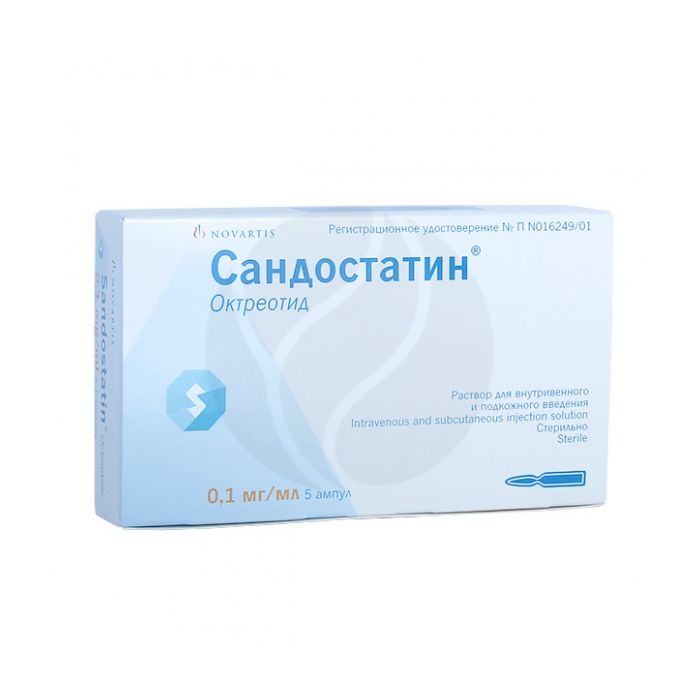Sandostatin solution for injection 0.1mg / 1ml, No. 5
Russian Pharmacy name:
Сандостатин раствор д/инъекций 0,1мг/1мл, №5
Acromegaly (with ineffectiveness or impossibility of surgical treatment, radiation therapy, or treatment with dopamine agonists);
endocrine tumors of the gastroenteropancreatic system (relief of symptoms of carcinoid tumors with signs of carcinoid syndrome, tumors characterized by overproduction of vasoactive intestinal peptide);
glucagonomas;
gastrinomas (Zollinger-Ellison syndrome), insulomas, VIPomas;
tumors characterized by hyperproduction of somatoliberin;
refractory diarrhea in AIDS patients;
pancreas surgery (prevention of complications);
bleeding (including prevention of relapse) with varicose veins of the esophagus and stomach in patients with cirrhosis of the liver (emergency treatment).
For acromegaly and tumors of the gastroenteropancreatic system, s / c - 0.05-1 mg 1-2 times a day, if necessary, the dose can be gradually increased to 0.1-0.2 mg 3 times a day;
refractory diarrhea in AIDS, s / c - 0.1 mg 3 times a day, it is possible to gradually increase the dose to 0.25 mg 3 times a day.
In order to prevent complications after pancreatic surgery, the first dose of 0.1 mg is administered subcutaneously 1 hour before laparotomy; then after surgery, s / c - 0.1 mg 3 times a day for seven consecutive days.
To stop bleeding from varicose veins of the esophagus or stomach, 25 mcg / h is administered by continuous intravenous infusion for 5 days.
The solution for intravenous and subcutaneous administration is transparent, colorless.
1 ml
octreotide (free peptide form) 100 mcg
Excipients: lactic acid, mannitol, sodium bicarbonate, carbon dioxide, water d / i.
Hypersensitivity.
pharmachologic effect
A synthetic analogue of somatostatin, characterized by a longer duration of action. Inhibits the secretion of STH by the anterior lobe of the pituitary gland, as well as the secretion of TSH. Inhibits exocrine and endocrine (insulin, glucagon) secretion of the pancreas, as well as the secretion of gastrin, hydrochloric acid, cholecystokinin, secretin, digestive enzymes, vasointestinal peptide and some other peptides, biologically active substances, the secretion of which is carried out by the gastroentero-pancreatic system. Suppresses gastric and intestinal motility.
Pharmacokinetics
After subcutaneous injection, it is rapidly and completely absorbed into the systemic circulation. Cmax of the active substance in plasma is reached within 30 minutes. Plasma protein binding is 65%. Binding to blood corpuscles is extremely insignificant. Vd is 0.27 l / kg.
The total clearance is 160 ml / min. T1 / 2 after subcutaneous injection - 100 min. After intravenous administration, the elimination process occurs in 2 phases, with T1 / 2 10 minutes and 90 minutes, respectively.
Side effect
From the digestive system: anorexia, abdominal pain, nausea, vomiting, bloating, diarrhea, steatorrhea; impaired glucose tolerance; rarely - severe pain in the epigastrium, tenderness on palpation, muscle tension of the abdominal wall, acute hepatitis, hyperbilirubinemia, increased activity of liver enzymes; with prolonged use in some cases - the formation of stones in the gallbladder.
Local reactions: pain, burning, itching, redness, swelling at the injection site.
Application during pregnancy and lactation
During pregnancy and lactation, octreotide should only be used under strict indications.
special instructions
The drug should be used with caution in cholelithiasis, diabetes mellitus.
An ultrasound examination of the gallbladder is recommended before and during treatment. It should be borne in mind that octreotide has no antitumor activity.
During the period of treatment, systematic monitoring of the concentration of glucose in the blood is necessary, especially in patients with bleeding from varicose veins of the esophagus with cirrhosis of the liver, because there is an increased risk of developing hyperglycemia.
Drug interactions
Somatostatin analogs can reduce the clearance of substances metabolized with the participation of isoenzymes of the cytochrome P450 system, which may be due to suppression of growth hormone.
With simultaneous use, the bioavailability of bromocriptine increases; with insulin - it is possible to increase the hypoglycemic effect; with cyclosporine - the absorption of cyclosporine decreases, with cimetidine - the absorption of cimetidine slows down.

